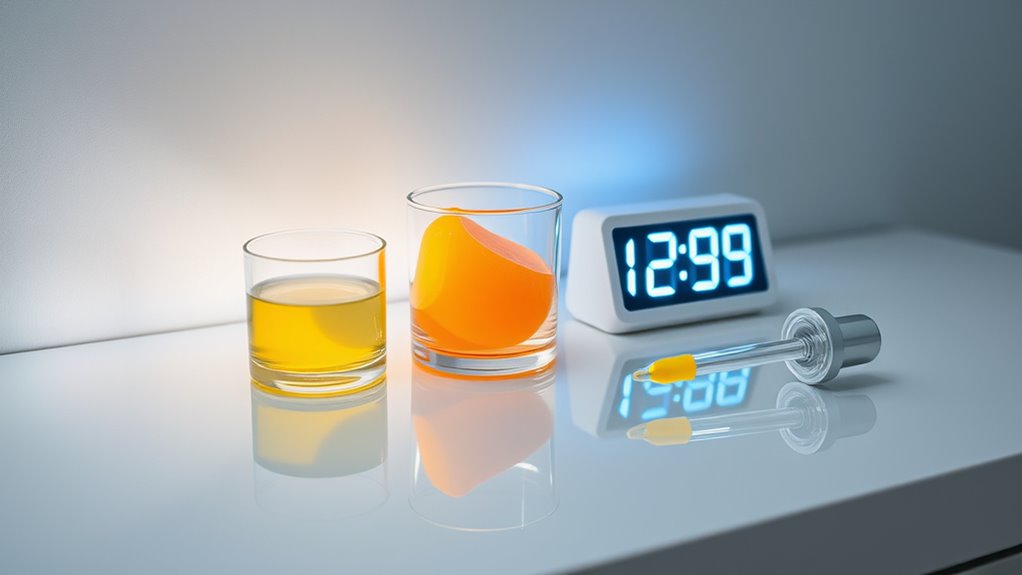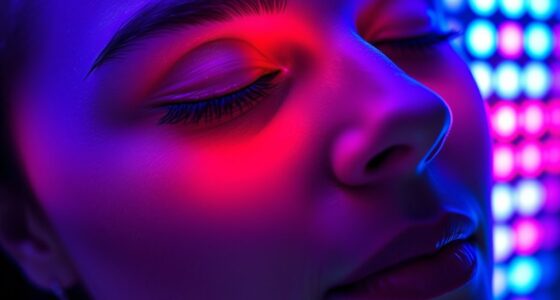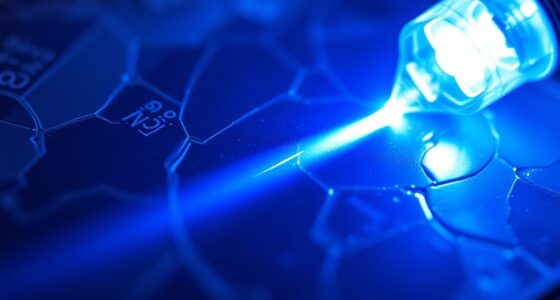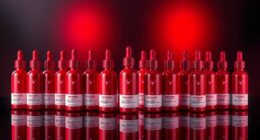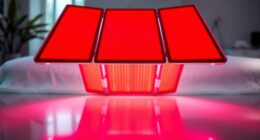To get the best results from LED therapy while using acids like AHA and BHA, it’s important to wait at least 24 to 48 hours after applying these exfoliants before your LED session. This gives your skin time to recover, reduce sensitivity, and guarantee ideal light penetration. Skipping this waiting period can lessen LED effectiveness and cause irritation. Keep exploring to discover how proper timing can boost your skincare routine even more.
Key Takeaways
- Wait at least 24 to 48 hours after applying acids before scheduling LED therapy.
- Proper timing allows skin recovery, ensuring LED treatment remains effective and safe.
- Excessive acid use or insufficient wait can reduce light penetration and diminish results.
- Longer intervals help minimize skin sensitivity and irritation during LED sessions.
- Monitoring your skin’s response guides optimal scheduling for healthier, more effective skincare routines.
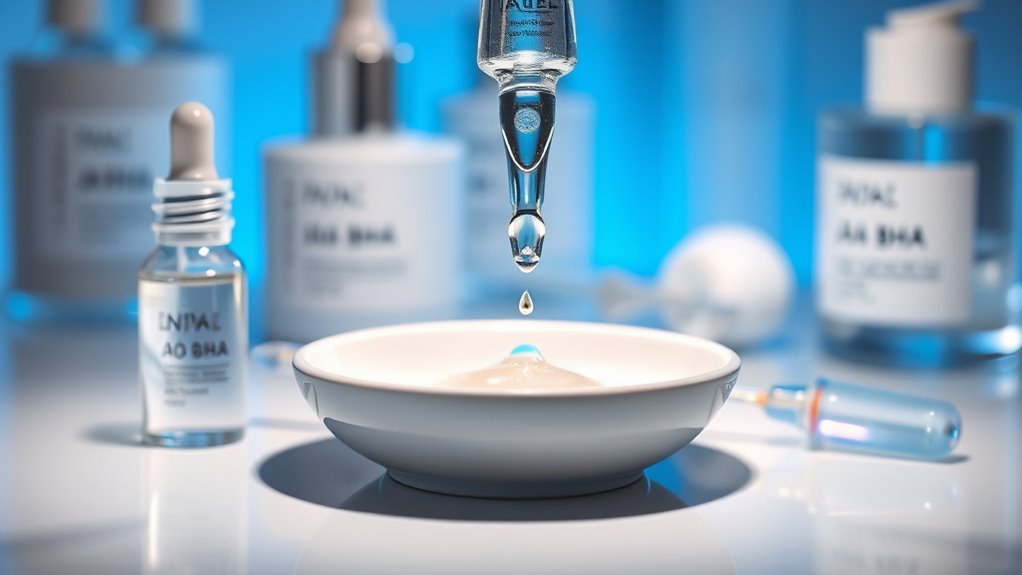
Have you ever wondered how acids can influence the behavior of LEDs? It might seem unrelated at first, but understanding the interaction between acids like AHA and BHA and light-emitting diodes can actually help you optimize your skincare routine. When you apply acids to your skin, they work by exfoliating the top layer, promoting cell turnover, and revealing fresher, brighter skin. However, if you’re also using LED treatments, it’s essential to know how these acids can impact the effectiveness of light therapy. The key lies in timing. Using acids immediately before an LED session can diminish the benefits because acids can temporarily alter your skin’s surface and sensitivity, making it less responsive to the light therapy.
To get the most out of your LED treatments, it’s recommended to space out the use of acids and light therapy sessions. For example, if you use a chemical exfoliant like AHA or BHA, wait at least 24 to 48 hours before your LED session. This waiting period allows your skin to recover from the exfoliation, restoring its natural barrier and sensitivity. When your skin is in its ideal state—neither overly sensitive nor compromised—you’ll notice that the LED therapy works more effectively. The light penetrates deeper, stimulating collagen production and reducing inflammation more efficiently.
Wait 24 to 48 hours after using acids before your LED treatment for optimal results and skin recovery.
Additionally, understanding the material properties of LED light and its interaction with skin can help you better tailor your routine for optimal results. Timing isn’t just about avoiding reduced results; it also helps prevent irritation. Acids can make your skin more susceptible to irritation from the light, especially if your skin is already sensitive or compromised from frequent exfoliation. By scheduling your acid treatments and LED sessions thoughtfully, you minimize the risk of redness, dryness, or discomfort. It’s also beneficial to pay attention to how your skin reacts. If you notice increased sensitivity after using acids, give yourself more time before the next LED session. Conversely, if your skin feels resilient and calm, you might be able to shorten the waiting period, but always err on the side of caution.
In essence, understanding the timing between acids and LED treatments helps you maximize the benefits of both. It’s about creating a routine that supports your skin’s health without overloading it. Incorporate your acids and LED therapy into your skincare schedule mindfully, and you’ll likely see better results, smoother skin, and fewer side effects. Remember, patience and observation are your best tools—listen to your skin, and adjust your routine accordingly. When you do, you’ll find that combining acids with LED therapy becomes a powerful way to enhance your skin’s appearance and health.
Frequently Asked Questions
Can LED Therapy Replace Chemical Exfoliants Entirely?
LED therapy can’t fully replace chemical exfoliants because they serve different purposes. LED treatments boost collagen, reduce inflammation, and improve skin tone, but they don’t remove dead skin cells like AHA/BHA acids do. Chemical exfoliants provide immediate, visible results by dissolving dead cells, while LED therapy offers gradual benefits. For ideal skin health, combining both can be more effective than relying on one alone.
Is It Safe to Combine LED With Other Skincare Treatments?
Did you know over 70% of skincare users combine treatments? It’s generally safe to combine LED therapy with other treatments, like acids or serums, but you should always consult your dermatologist first. LED’s gentle light can enhance your skincare routine without causing irritation. Just guarantee treatments are spaced out properly and follow professional advice to avoid overloading your skin. Proper coordination maximizes benefits and keeps your skin safe.
How Often Should I Use LED With Acids for Best Results?
You should use LED therapy with acids 2 to 3 times a week for ideal results. Make sure to space out treatments to allow your skin to recover and avoid irritation. Always follow the specific product instructions and listen to your skin’s response. If you notice redness or discomfort, reduce the frequency. Consistency is key, so stick to your routine and be patient for the best glow and clarity.
Are There Any Skin Types That Shouldn’T Use LED With Acids?
Like a knight avoiding dragons, you should be cautious if you have very sensitive or reactive skin. People with rosacea, eczema, or severe acne might find LED with acids too harsh, causing irritation or redness. Always patch-test first and consult your dermatologist. While many can benefit, if your skin is prone to inflammation or breakouts, it’s best to proceed carefully or avoid combining these treatments altogether.
What Are the Long-Term Effects of Combining LED and Acids?
Long-term, combining LED and acids can improve your skin’s texture and clarity, but it may also cause sensitivity or irritation if overdone. You might notice increased dryness or redness, especially if you have sensitive skin. To minimize risks, use these treatments as recommended and give your skin time to recover. Consistent, cautious use can enhance your skin’s health, but overuse could lead to long-term damage or imbalance.
Conclusion
Just as the stars align in the night sky to guide sailors home, understanding the timing of your AHA and BHA treatments steers your skin toward clarity and radiance. When you harness the right intervals, you reveal the secret to a balanced, luminous complexion—like a well-orchestrated symphony. Remember, patience and consistency are your compass in this journey. Trust the process, and your skin will shine as brightly as the dawn after a long night.
